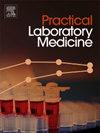Application and concentration selection of dithiothreitol for correcting false elevation of D-dimer
IF 1.7
Q3 MEDICAL LABORATORY TECHNOLOGY
引用次数: 0
Abstract
Background
Immunological methods for D-dimer detection are prone to interference, leading to falsely elevated values. This study evaluates the optimal concentration and corrective efficacy of dithiothreitol (DTT) in addressing false D-dimer elevations.
Methods
Plasma samples from seven patients with falsely elevated D-dimer levels, identified using the Sysmex CS5100 coagulation analyzer, were analyzed. Correction was performed using the Stago STA-R Max analyzer with alternative detection antibodies. Additionally, plasma samples from thirty patients with confirmed D-dimer elevations were treated with varying concentrations of DTT (0.01, 0.05, 0.10, and 0.20 mol/L) and normal saline (NS). The optimal concentration of 0.01 mol/L DTT was identified and applied to the experimental group. The results were compared with those obtained using an alternative immunoassay method.
Results
In the true elevation group, samples treated with 0.01 mol/L DTT showed no significant difference in D-dimer levels compared to the NS control or original results (all P > 0.05). Higher concentrations of DTT significantly lowered D-dimer levels compared to the NS group (all P < 0.05). In the experimental group, 0.01 mol/L DTT treatment and the alternative immunoassay method similarly reduced D-dimer levels, with no significant difference between the two correction methods (P > 0.05).
Conclusion
A 0.01 mol/L DTT solution effectively corrects falsely elevated D-dimer levels without affecting true elevations, yielding results comparable to those achieved by changing the immunoassay method.
二硫苏糖醇在纠正d -二聚体假升高中的应用及浓度选择
d -二聚体检测的免疫学方法容易受到干扰,导致错误的升高值。本研究评估了二硫苏糖醇(DTT)在解决假d -二聚体升高中的最佳浓度和矫正效果。方法采用Sysmex CS5100凝血分析仪对7例d -二聚体水平虚高患者的血浆样本进行分析。校正使用Stago STA-R Max分析仪与替代检测抗体。此外,对30例确诊d -二聚体升高的患者的血浆样本进行不同浓度的DTT(0.01、0.05、0.10和0.20 mol/L)和生理盐水(NS)治疗。确定了0.01 mol/L DTT的最佳浓度,并应用于实验组。将结果与采用另一种免疫测定方法获得的结果进行比较。结果在真抬高组中,0.01 mol/L DTT处理的样品d -二聚体水平与NS对照组或原始结果相比无显著差异(P >;0.05)。与NS组相比,高浓度DTT显著降低d -二聚体水平(P <;0.05)。在实验组中,0.01 mol/L DTT处理与替代免疫分析法相似地降低了d -二聚体水平,两种校正方法之间无显著差异(P >;0.05)。结论0.01 mol/L DTT溶液可有效纠正假升高的d -二聚体水平,而不影响真实升高,其结果与改变免疫测定方法的结果相当。
本文章由计算机程序翻译,如有差异,请以英文原文为准。
求助全文
约1分钟内获得全文
求助全文
来源期刊

Practical Laboratory Medicine
Health Professions-Radiological and Ultrasound Technology
CiteScore
3.50
自引率
0.00%
发文量
40
审稿时长
7 weeks
期刊介绍:
Practical Laboratory Medicine is a high-quality, peer-reviewed, international open-access journal publishing original research, new methods and critical evaluations, case reports and short papers in the fields of clinical chemistry and laboratory medicine. The objective of the journal is to provide practical information of immediate relevance to workers in clinical laboratories. The primary scope of the journal covers clinical chemistry, hematology, molecular biology and genetics relevant to laboratory medicine, microbiology, immunology, therapeutic drug monitoring and toxicology, laboratory management and informatics. We welcome papers which describe critical evaluations of biomarkers and their role in the diagnosis and treatment of clinically significant disease, validation of commercial and in-house IVD methods, method comparisons, interference reports, the development of new reagents and reference materials, reference range studies and regulatory compliance reports. Manuscripts describing the development of new methods applicable to laboratory medicine (including point-of-care testing) are particularly encouraged, even if preliminary or small scale.
 求助内容:
求助内容: 应助结果提醒方式:
应助结果提醒方式:


